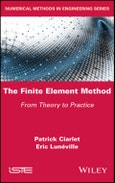The finite element method, which emerged in the 1950s to deal with structural mechanics problems, has since undergone continuous development. Using partial differential equation models, it is now present in such fields of application as mechanics, physics, chemistry, economics, finance and biology. It is also used in most scientific computing software, and many engineers become adept at using it in their modeling and numerical simulation activities.
This book presents all the essential elements of the finite element method in a progressive and didactic way: the theoretical foundations, practical considerations of implementation, algorithms, as well as numerical illustrations created in MATLAB. Original exercises with detailed answers are provided at the end of each chapter.
Table of Contents
Preface ix
Chapter 1 Theoretical Aspects of Elliptic Equations 1
1.1. Some vocabulary 1
1.1.1. Boundary conditions for the Laplace equation 3
1.1.2. Other boundary conditions 4
1.2. Classical solutions to Laplace’s equation 5
1.2.1. Green's formulae 5
1.2.2. The maximum principle 8
1.3. Weak solutions 9
1.4. Reminders on Banach and Hilbert spaces 11
1.4.1. Banach spaces 12
1.4.2. Hilbert spaces 13
1.5. Sobolev spaces 16
1.5.1. Differentiation in the distribution sense 17
1.5.2. "Sufficiently regular" boundaries 23
1.5.3. Differentiation in the classical or distribution sense? 25
1.5.4. A compactness result 26
1.6. Existence of the trace and integration by parts formulae 27
1.7. Exercises - statements 35
Chapter 2 Variational Formulations and Their Solutions 43
2.1. Variational formulations of the Dirichlet, Neumann and Fourier problems 43
2.1.1. Homogeneous Dirichlet problem 43
2.1.2. Non-homogeneous Dirichlet problem 46
2.1.3. Neumann and Fourier problems 47
2.2. Other variational formulations examples 50
2.2.1. Variable coefficient problems 50
2.2.2. Second-order elliptic problems 51
2.2.3. Higher order problems 51
2.2.4. Less-regular data 52
2.3. Existence and uniqueness of weak solutions 53
2.3.1. Neumann problem 54
2.3.2. Dirichlet problem - Poincaré’s inequality 56
2.3.3. The non-homogeneous Dirichlet problem 59
2.4. Existence and uniqueness - general framework 60
2.4.1. Lax-Milgram theorem 61
2.4.2. An example application of the Lax-Milgram theorem with the Laplacian 64
2.4.3. The Helmholtz problem 67
2.4.4. Well-posed problems 71
2.4.5. The Banach-Necas-Babuska theorem 72
2.4.6. Fredholm alternative 76
2.5. Some properties of weak solutions 78
2.5.1. Maximum principle 79
2.5.2. Regularity of the solutions 81
2.6. Exercises - statements 85
Chapter 3 Introduction to the Finite Element Method 95
3.1. Galerkin’s approximation 95
3.1.1. Case of a coercive form 97
3.1.2. Case of a form satisfying the stability and solvability conditions 101
3.1.3. Approximation example: Hilbert bases 104
3.1.4. Different solution and test-function spaces 105
3.2. Principles of the affine finite element method in two dimensions 107
3.2.1. Mesh 107
3.2.2. Global basis functions properties 110
3.2.3. Norm of the elements of the approximation space 112
3.2.4. Sparse matrix property 113
3.2.5. Lagrange interpolation 113
3.2.6. Local nature of the finite element method 113
3.3. General procedure of constructing finite elements 117
3.3.1 Lagrangian finite elements of order k 117
3.3.2. Examples of finite elements 118
3.3.3. Constructing the approximation space 127
3.3.4. Two-dimensional examples of assembly 129
3.4. Extension of finite elements 133
3.4.1. Hermitian finite elements 134
3.4.2. “Moment”-type finite elements 135
3.4.3. Constructing the approximation space 136
3.4.4. Vectorial finite elements 137
3.5. Exercises - statements 137
Chapter 4 Numerical Analysis of the Finite Element Method 143
4.1. Convergence of finite element methods 143
4.1.1. Local interpolation error 145
4.1.2. Estimating errors in the finite element method 152
4.1.3. “Piecewise regular” solutions 156
4.2. Error estimators and mesh refinement 160
4.3. Non-polyhedral domains and approximations of the data 163
4.3.1. Non-polyhedral open subsets 163
4.3.2. Isoparametric finite elements 167
4.3.3. Approximation of the data 168
4.4. Exercises - statements 172
Chapter 5 Concrete Aspects of the Finite Element Method 185
5.1. Implementation 185
5.1.1. Finite element meshes 186
5.1.2. Basic calculations 189
5.1.3. Assembly of the global matrices and the right-hand side 191
5.1.4. Eliminating the essential boundary conditions 195
5.2. Algorithmic considerations 199
5.2.1. A particular case 200
5.2.2. The general 2D case 200
5.2.3. The general 3D case 205
5.3. Some numerical illustrations 207
5.3.1. The Laplace equation 208
5.3.2. The diffusion equation 213
5.3.3. Bidimensional elasticity 215
5.3.4. Some elementary tools for 2D meshes 222
Appendices 231
Appendix 1 Solving Linear Systems 233
Appendix 2 Solutions 271
Appendix 3 Formulas 369
References 371
Index 373








